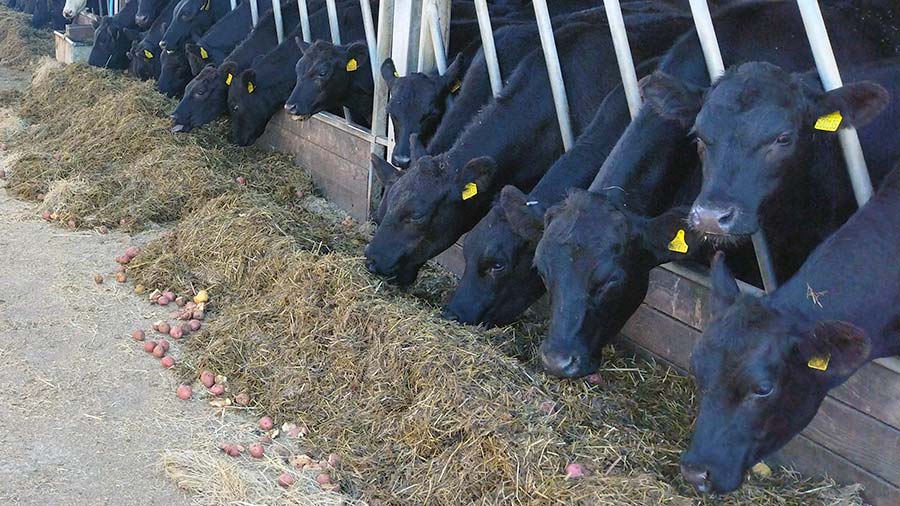Prolonged dry spell heightens fears of winter forage shortage
 Youngstock housed and being fed TMR due to lack of quality grazing at Rob Halliday's farm near Liskeard Cornwall © Rob Halliday
Youngstock housed and being fed TMR due to lack of quality grazing at Rob Halliday's farm near Liskeard Cornwall © Rob Halliday A looming forage shortage caused by hot weather and the ongoing lack of rain is set to add to livestock farmers’ high costs of production this winter.
Months of dry weather have severely hampered grass growth, and a shortage of forage for beef, sheep and dairy farmers is already forcing some to break into their winter fodder supplies.
The prolonged dry spell is also raising concern over growing prospects for stubble turnips, forage rape, grass silage and maize.
See also: Advice on coping with feed shortage as heat burns off grass
There is huge variation across the country, however, with southern and south-west England and eastern counties the most severely affected.
By contrast, forage stocks in south-west Scotland and in Cumbria are at normal or very good levels.
NFU dairy board chairman Michael Oakes said dairy farmers had been trying to grow more grass to reduce margins and costs, but some faced buying-in costly extra feed.
Mr Oakes, a tenant dairy farmer based just outside Birmingham, said:
“We’re eating into our first-cut silage quite quickly. There will not be a lot left going into the winter. Second cut was average on quantity and third cut is looking very, very light.”
Maize crops ‘poor’
In addition, Mr Oakes said some maize crops looked poor – his own were “shrivelled and spiky”, resembling pineapple plants.
Dairy consultant Paul Macer, partner at Kite Consulting, said dairy farmers in affected areas might have to feed an additional 2-3kg dry matter of concentrates through the winter to compensate for lack of forage, as they did in the previous drought in 2018.
“Concentrates will be twice the cost of forage. It will probably add about 1-2p/litre to milk production costs on those farms,” he added.
Cornwall NFU chairman Rob Halliday, who farms 370 head of cattle and 150 ewes across two farms near Liskeard, said he faced “the longest winter ever”.
“I hope we’ve made enough early-season silage to cover the prolonged feeding period, but I’m concerned about not being able to establish green crops for winter grazing,” he said.
Earlier this week, Mr Halliday housed 80 youngstock and gave them a simple total mixed ration (TMR) feed after their growth rates dropped significantly.
“There’s no point panicking. It’s a case of making proactive decisions now,” he said.
The lambs have also been weaned off ewes to preserve ewe condition and a stock of grass for lambs.
Dilemma
Phil Stocker, chief executive of the National Sheep Association, said: “Some sheep farmers are already feeding winter forage stocks out on fields. There could be some serious forage shortages if we’re not careful this year.”
He added that lambs were “just not finishing in this heat” and sheep farmers faced “a real dilemma” now as to whether they push to finish their lambs or allow them to go into a store condition.
But Mr Stocker said lamb prices were still holding firm, particularly for good-quality sheep.
The Met Office has issued an extreme heat warning, which covers much of southern England and eastern parts of Wales, until late on Sunday 14 August.
However, rain is forecast for many regions on Monday 15 August, followed by more changeable weather.
How to deal with the forage shortfall
Farmers are being urged to assess their winter forage stocks and develop a plan now, following the extended dry spell.
Paul Macer, partner at Kite Consulting, said dairy farmers could still make a late cut of silage when the rain did come, and/or consider sourcing forage from surplus areas.
Catch crops could also be drilled if weather conditions allowed.
Dairy farmers could also seek forage replacers such as pressed sugar beet pulp, and look at straw-based rations for followers.
“Source sufficient concentrates so you can feed the cows properly, since the milk price-feed price ratio should be good,” Mr Macer added.
James Hadwin, an independent beef and sheep consultant based in Cumbria, urged sheep farmers to look at their available grazing and prioritise where it was needed to ensure their ewes were in target body condition score, ready for tupping.
“Prioritise leaner ewes to increase their body condition score and use electric fencing or paddock grazing to allocate grazing accordingly,” he said.
“Beef farmers should consider selling cattle that are out of their calving pattern to cut their grazing demand, especially while cull prices are good.”
